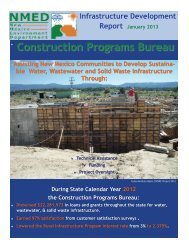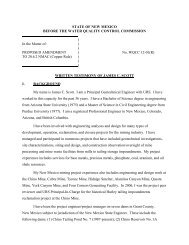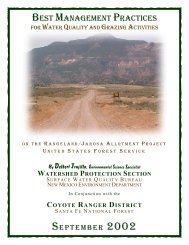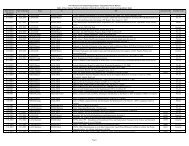Upper Gila Watershed, Taylor Creek - New Mexico Environment ...
Upper Gila Watershed, Taylor Creek - New Mexico Environment ...
Upper Gila Watershed, Taylor Creek - New Mexico Environment ...
Create successful ePaper yourself
Turn your PDF publications into a flip-book with our unique Google optimized e-Paper software.
Past and Ongoing Monitoring Efforts<br />
<strong>Watershed</strong> Assessment and Monitoring<br />
<strong>Upper</strong> <strong>Gila</strong>, <strong>Taylor</strong> <strong>Creek</strong><br />
<strong>Watershed</strong> Restoration Action Strategy<br />
July 2005<br />
GNF Terrestrial Ecosystem Survey 1985<br />
The Beaverhead Terrestrial Ecosystem Survey included soil classification and<br />
mapping of soil types for the entire <strong>Taylor</strong> <strong>Creek</strong> watershed. Terrestrial<br />
ecosystems are recognized by the interaction of three major components – soil,<br />
climate, and vegetation. Nineteen individual mapping units are present in the<br />
survey based on the three major components. The survey indicates the typical<br />
variability of sediment yield in western upland landscapes like <strong>Taylor</strong> <strong>Creek</strong><br />
watershed. (The complete Beaverhead TES should be included as Appendix 1)<br />
NRCS PSIAC Evaluation 2005<br />
The watershed was broken into 14 areas based on sub-drainages and geomorphic<br />
zones. Pacific Southwest Inter Agency Committee (PSIAC) sediment yield<br />
evaluations were taken at representative sites within these areas. A map of these<br />
described areas is found on page 20, and a chart exhibiting the acreage, identified<br />
planned practices, estimated load reductions from implementation of proposed<br />
best management practices, and stakeholders within the area on page 19. Report<br />
with details attached in appendix 2)<br />
Fire Regime Condition Class Landscape Assessment<br />
The GNF Fire Regime Condition Class (FRCC) landscape scale assessment maps<br />
can be used for assessment of vegetation conditions within a watershed. The<br />
FRCC is not a direct indicator of fire hazard but does indicate where vegetation<br />
conditions have departed from expected natural ecological conditions. Graphic<br />
examples of Fire Regime Condition classes are shown in the three side-by-side<br />
images below. For the maps attached in Appendix 4, Condition Class 1<br />
corresponds to 0-33%, Condition Class 2 corresponds to 33-66% and Condition<br />
Class 3 corresponds to 66-99%. FRCC and associated maps can be used for<br />
prioritizing thinning projects and prescribed burns thereby directing project<br />
planners to areas most in need of treatment.<br />
16 of 22









